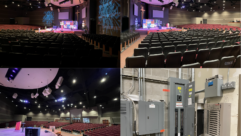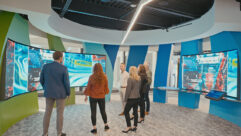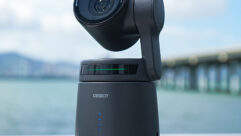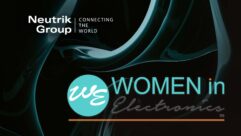
A Brighter Future
THE PROJECTOR MARKET HAS CERTAINLY come a long way in the last 20 years. Back in the 1980s, ?projection? meant three converged cathode-ray tubes (CRT) in a large, heavy chassis, barely lighting up a 100-inch screen in a darkened room. For more horsepower, a hybrid liquid-crystal light valve, coupled with a smaller CRT and powered by a xenon arc lamp, required several square feet of floor space just to crank out a few thousand lumens. Both solutions were expensive and required skilled technicians to calibrate and operate. Thanks to plug-and-play projector designs that use high-resolution transmissive or reflective imaging devices, these are a thing of the past.
THE PROJECTOR MARKET HAS CERTAINLY come a long way in the last 20 years. Back in the 1980s, “projection” meant three converged cathode-ray tubes (CRT) in a large, heavy chassis, barely lighting up a 100-inch screen in a darkened room. For more horsepower, a hybrid liquid-crystal light valve, coupled with a smaller CRT and powered by a xenon arc lamp, required several square feet of floor space just to crank out a few thousand lumens. Both solutions were expensive and required skilled technicians to calibrate and operate. Thanks to plug-and-play projector designs that use high-resolution transmissive or reflective imaging devices, these are a thing of the past.Note the mention of mercury, an essential component of UHP, UHE, and similar projection lamps, as well as the cold-cathode fluorescent lamps (CCFLs) used in LCD monitors. What are the alternatives to short-arc metal-halide lamps? Are any of those alternatives truly ready for prime time?LEDs have several distinct advantages over short-arc lamps. First, they are instant-on devices. Images are ready for viewing within a few seconds of applying power to the RPTV. Second, LEDs can create much higher levels of saturation for each color channel, resulting in a very wide color gamut with hundreds of millions of possible shades.Another projection illumination technology that shows promise is the laser, although many industry analysts remain skeptical about its practicality. That’s because laser light is, by nature, coherent or tightly focused. In contrast, projection light is more diffused as it moves through the optical engine in a projector.Necsel emitters are constructed with standard indium-galliumarsenide (InGaAs) semiconductor materials, and according to Novalux, produce diffraction-limited Gaussian beams of infrared (IR) light that are easily frequency-doubled to the appropriate wavelengths of visual light. The company also claims that mass-production of Necsel devices is achievable with excellent yields and competitive prices.Lasers are also environmentally friendly. However, care must be taken to seal the laser engine away from prying eyes. Coherent light can cause serious damage to the retina with relatively short exposure, therefore, a suitable housing must be devised that is secure from prying fingers.In terms of power consumption, the LiFi light source currently in production isn’t as efficient as a conventional short-arc design with its ballast. To achieve the brightness of a 120-watt UHP lamp, the LiFi engine requires about 260 watts of energy, showing once again that there’s always a trade-off with new technologies. However, Luxim claims that its newest design, the LiFi 8000, meets current efficiency benchmarks for home theater projectors.
Gregg Hollingsworth, vice president of product development at Sunnyvale, Calif.–based Luxim Corp., demonstrates how revolutionary new light sources can bring bold improvements to projection display.”/>
Gregg Hollingsworth, vice president of product development at Sunnyvale, Calif.–based Luxim Corp., demonstrates how revolutionary new light sources can bring bold improvements to projection display.
Since 1990, panel and chip sizes have shrunk numerous times, while native resolutions have doubled and tripled into millions of pixels. Projector housings have gotten smaller; cooling systems have become more efficient and quieter; lens options are numerous; and any PC or video signal format can be supported — analog or digital. About the only thing that hasn’t changed much over the past two decades is the projection lamp. To be sure, the compact, high-efficiency mercury-vapor designs used today are a far cry from the baton-like metal-halide lamps that inhabited so-called portable projectors in the early 1990s, many of which weighed 30 to 50 pounds.
While the size of these lamps has shrunk, their function remains basically the same. A high-voltage discharge between the lamp electrodes ionizes a mixture of gases and dissolved metal salts, producing a brilliant discharge of photons — for a few thousand hours, that is, at which point the gas/metal mixture finally gives up the ghost.
Even the best lamps aren’t all that efficient. A substantial amount of the power consumed by a projection lamp is dissipated as heat, not as useful photons. Their relatively short life and high cost of replacement is also a drawback. Xenon arc lamps can drop to half-brightness in as little as 500 hours to 1,000 hours at a cost of about $1 per watt.
Cost issues aside, there’s also the growing green movement to contend with. The European Union’s Reduction of Hazardous Substances (RoHS) regulations are intended to remove toxic substances from everyday electronic items. The EU’s directive bans the placement of new electrical and electronic equipment containing more than agreed levels of “lead, cadmium, mercury, hexavalent chromium, polybrominated biphenyl (PBB), and polybrominated diphenyl ether (PBDE) flame retardants” in the EU market.
An angled view of a PhlatLight green-light emitting diode module.
THE MIGHTY DIODE
One logical place to look for next-generation illumination technology is in the area of light-emitting diodes (LED). For most of us, the LED is a tiny green, red, blue, or yellow power indicator on our AV receiver or TV. Perhaps you have a novelty LED flashlight on your keychain or a string of decorative LED lights for the holidays. But the fact is LEDs are a viable solution for today’s projection applications.
While not bright enough for large venue projection, LEDs are now being used to illuminate several models of DLP rear-projection HDTVs manufactured and sold by NuVision, a high-performance LCD display company located in Scottsdale, Ariz., and Samsung, the electronics giant based in South Korea.
The actual diodes, manufactured by Woburn, Mass.–based Luminus Devices, are known as PhlatLight — a contraction of photonic lattice light. Originally developed at the Massachusetts Institute of Technology in Cambridge, Mass., the photonic lattice is a tiny array of photon emitters mounted to the surface of a microchip. Three chips are used for color imaging — one red, one green, and one blue — eliminating the need for both a projection lamp and a mechanical color wheel (the system used with conventional single-chip DLP front and rear projectors). The three-chip system works just as well with high-temperature polysilicon (HTPS) and liquid crystal on silicon (LCoS) projection engines.
A conventional single-chip DLP projection engine is made simpler with lasers as the lamp, integrator, and color wheel are all eliminated.
LEDs also have no particular color bias, unlike a short-arc lamp that produces uneven spectral light, concentrating near blue-green and weakening in reds and yellows. In contrast, LED color is pure at the specific frequency, making neutral white balance adjustments far simpler.
The final advantage of LEDs is their shelf life, which typically runs 50,000 hours or more. That’s 20 to 25 times the life of a typical UHP lamp and 50 times the life of xenon lamps. LEDs are also much smaller than short-arc lamps, allowing for more compact light engines, combining prisms, and polarizing beam splitters.
What’s the downside? LEDs are, and always will be, current-hungry devices. That trade-off in power consumption would appear to negate their green advantage. To get around the problem, LEDs can be operated in a pulsed mode — flashed on and off several hundred times a second, fast enough to avoid visible flicker. Not only does this technique lower power consumption, but it also improves rendering of fast motion — one reason LEDs are also strong candidates to replace cold-cathode fluorescent lamps in large LCD monitors and displays.
Presently, there are no high-power LED front projectors, although a number of companies, including Samsung and Mitsubishi, are now selling pocket LED DLP projectors capable of producing a few tens of lumens at SVGA (800 x 600) resolution.
BEAM US UP
LIGHTING THE WAY:Lamp life comparison among current and future light source alternatives.”/>
LIGHTING THE WAY:Lamp life comparison among current and future light source alternatives.
Coherent light, although extremely bright at relatively low power levels, creates an optical phenomenon known as speckle. To the naked eye, images and characters traced by laser light beams appear to have a granular appearance — one that constantly shifts as the perspective of the observer changes. This granular characteristic does not match up well with textured screen surfaces such as beaded front screens and microlens rear screens. In 2006, Mitsubishi showed a prototype of a laser-powered DLP rear-projection HDTV that suffered from excessive speckle caused by the laser optically “beating” with the pattern of microlenses in the TV’s screen.
The challenge for laser light sources is to find the sweet spot at which speckle ceases to be a problem while the laser is still bright enough to function as an illuminant. There have been different approaches to diffusing or homogenizing laser light, including the use of diffusing materials and interference gratings. One demonstration in the late 1990s by COLOR, a laser research firm in New Hampshire, required optical benches measuring 12 feet on a side, dotted with mirrors, diffusors, lenses, and the optical prism and LCD imaging panels salvaged from a Sony XGA-resolution business projector. It also required three racks of power supplies to operate the diode-pump lasers!
Things have come a long way since then. Several companies have shown prototype laser light engines for projection applications, including Coherent Technologies, in Santa Clara, Calif., and Novalux in Sunnyvale, Calif. Novalux has developed a range of surface-mount diode lasers that have been demonstrated in rear-projection DLP HDTVs at the Society for Information Display trade show and Consumer Electronics Show (CES). This line of lasers, known as Necsel, has a very small footprint, but can produce a considerable amount of light energy.
Luxim Corp.’s LiFi 4000 light source uses no electrodes and is activated by RF energy.
Once again, the use of discrete red, green, and blue light sources simplifies optical engines considerably. In a single-chip DLP projector, the color wheel is removed, and the lasers are sequenced accordingly. In a 3LCD projector, the dichroic filters are also removed, leaving just the combining prism.
It’s important to note that coherent light sources also eliminate the need for light integrators and condensers. The Necsel laser diodes deliver homogenized light, diffused enough to eliminate problems with speckle and granularity. In effect, the tri-color lasers modulate each LCD panel directly, boosting efficiency and cutting down on power consumption.
At present, Necsel can produce about 1,000 lumens in a tri-stimulus projection engine — sufficient for home theater or darkened rooms and more than enough light for rear projection screens. Novalux also plans to offer higher power versions for higher-brightness projectors, using fiber-optic coupling to combine Necsel arrays.
What advantages do lasers have over short-arc lamps? To begin, the lasers should last about 30,000 hours before any significant decrease in brightness is seen. Like LEDs, lasers are also instant-on devices with short power-down cycles. Lasers also produce highly saturated colors, resulting in very wide color gamuts — wider than those of LEDs.
Gregg Hollingsworth (left) and Richard Gilliard (right) demonstrate the company’s smaller, brighter LiFi 8000 for home theater projectors.
Power consumption and cooling are also issues that require fine-tuning. The first problem can be solved by pulsing the lasers on and off at high frequencies, also improving motion rendering. The second problem remains a challenge — demonstrations of laser-equipped RPTVs to date have required large arrays of cooling fans around the base of the TV, which doesn’t compare favorably to super-thin LCD and plasma HDTVs.
HIGH-TECH NEWCOMER
Despite advances in LED and laser technology and the prevalence of UHP designs, there may be another alternative. Sunnyvale, Calif.–based Luxim Corp. has commercialized an ingenious new light source by eliminating the primary source of lamp failures — the electrodes.
Luxim’s approach, shown at CES 2007, is to create a sealed lamp assembly with the appropriate gases and metal vapors and place it into a chamber where it’s bombarded with radio frequency (RF) energy. At a certain level of bombardment, the gas/halide mixture ignites, just like a conventional lamp. The resulting light is channeled through a small opening at the end of the chamber and then through a conventional optical engine. This Light Fidelity technology (LiFi) is already being used in a line of Panasonic RPTVs using HTPS LCD technology. In a LiFi light source, a combination of gases and metal salts ionize, just as they do in a conventional lamp. A microwave amplifier with a feedback loop maintains constant excitation for consistent light output.
According to Luxim, a LiFi light source should last at least 25,000 hours before dropping to 80 percent of initial brightness. It also has better spectral energy distribution than conventional UHP and UHE lamps, as its spectral output curve resembles that of a xenon lamp. Switch-on time is about 10 seconds to full brightness, and the lamp can restrike after 20 seconds. Luxim also claims fast dimming time for dynamic contrast operation. Light output can drop down to 25 percent in 50 milliseconds and recover just as quickly.
LIFI LIGHTING TECHNOLOGY
ON THE HORIZON
While other illumination systems for projectors are being proposed, investigated, and tested, none are as far along in development as LEDs and lasers. It’s a sure bet that we’ll see more projection systems moving to either of these two platforms as the costs of both continue to drop. On the other hand, flat-panel displays continue to grow in size. One could argue that smaller projection screens (up to 100 inches) will go away altogether as LCD and plasma prices continue to fall, and a two-piece projection system can be replaced by a single display (or tiled displays) that will work under any kind of ambient light.
Where LEDs and lasers will have their greatest impact is on microsized projectors that you can hold in your hand and keep in your pocket. Several demonstrations have been made of palm-sized and even finger-sized “pico” projectors that use laser light engines. Presumably, these will be incorporated into hand-held electronic devices like cell phones and PDAs.
So what’s to come of the time-tested short-arc metal-halide projection lamp? Its ultimate fate remains uncertain. For now, it remains the most cost-effective way to illuminate large screens and reflective surfaces, despite the movement toward more energy-efficient, less toxic energy sources.
PRO AV contributing editor Pete Putman is president of ROAM Consulting in Doylestown, Pa. You can reach him at [email protected].










